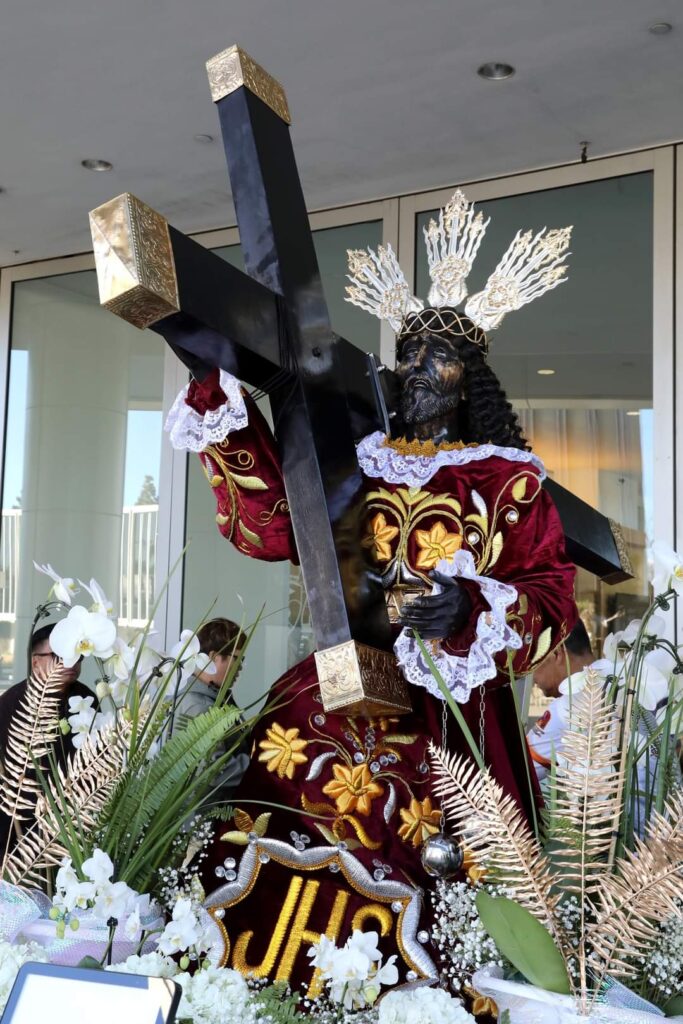Poon Jesus Nazareno
Schedule of Visit
July 20-26, 2024 – St Nicholas Church (Laguna Woods, CA)
Aug 10-24, 2024 – St Irenaeus Church (Cypress, CA)
Sep 7-14, 2024 – Holy Family Church (Artesia, CA)

History
In 1606, a group of Augustinian Recollect missionaries led by Fr. Benito de San Pablo from Spain journeyed from Mexico to Manila. They brought with them religious images from Acapulco Mexico, which depicted the Passion of Christ. One of them is that of Christ Carrying the Cross called the “Black Nazarene” (Poon Jesus Nazareno). The Black Nazarene has a dark hue because the image was originally carved from very dark timber called mesquite.
Some years after its arrival in the Philippines, the Friars were reportedly afraid that the growing number of devotees, wanting to pay reverence would eventually damage the image. They ordered a replica to be made which was sent to Manila. These two images were kept in the Church in Intramuros. On Jan. 9, 1787, Archbishop Basilio Sancho de Santa Justa y Rufina ordered the transfer of one of the images to the Church in Quiapo. (The other image of the Black Nazarene got destroyed in the Battle of Manila). The Church then made it an annual practice to bring out this image and parade it on the streets to commemorate the transfer of the Black Nazarene from Intramuros to Quiapo Church. This became its Feast Day, called the “Traslacion” (transferring of a sacred object), celebrated every January 9.
In 1650, Pope Innocent X approved the veneration of the image as a sacramental. In 1880, Pope Pius VII granted a Plenary Indulgences to those who would pray piously before the image of the Black Nazarene. And in 1987, Pope John Paul II raised the status of the Black Nazarene Shrine in Quiapo, Manila to that of a Minor Basilica.
What attracts Filipinos to the Black Nazarene? First, they are reminded of the great Love of God, who willingly accepted His Passion and Death on the Cross, to save humanity. Filipinos strongly identify with the passion and suffering of Jesus that the image depicts. Many devotees of the Black Nazarene relate their poverty and daily struggles to the Passion of Christ as He carried His Cross. Many also believe in its miraculous powers, with numerous devotees testifying that they were cured of illnesses, their prayers answered, like having a child, family relationships were saved, passing difficult exams, or even receiving job offers and many other testimonies by simply praying to the Black Nazarene.
To help spread the devotion to Poon Jesus Nazareno, the Archdiocese of Manila commissioned a Filipino sculptor to make some replicas of the image of the Black Nazarene. The image we now have in the Diocese of Orange was donated to the Religious Institute of Alagad Ni Maria, which works alongside the Diocese of Orange San Jose Filipino Ministry in spreading the devotion to Poon Jesus Nazareno. It is one of the official replicas from the Minor Basilica of the Black Nazarene in Quiapo, Manila. In the Philippines, every Friday is known as “Quiapo Day” since the novena prayers for the Black Nazarene is held on this day nationwide. At the end of each Mass in the Basilica, devotees pay homage to the Lord by clapping their hands. Some devotees express their veneration by kissing the Foot of the Black Nazarene (Paghalik) or wiping their handkerchief (Pagpupunas). The Black Nazarene is the most popular devotion among Filipinos. Millions of Catholic devotees participate in the procession during its Feast Day.



